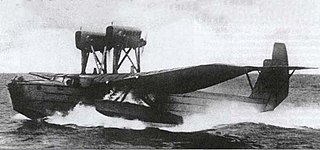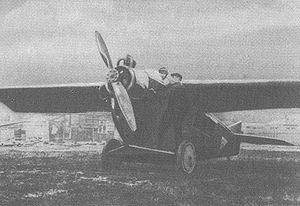
Andrei Nikolayevich Tupolev was a Soviet aeronautical engineer known for his pioneering aircraft designs as Director of the Tupolev Design Bureau.
Tupolev, officially Joint Stock Company Tupolev, is a Russian aerospace and defence company headquartered in Basmanny District, Moscow.

The Tupolev ANT-20 Maksim Gorki was a Soviet eight-engine aircraft, the largest in the world during the 1930s. Its wingspan was similar to that of a modern Boeing 747, and was not exceeded until the 64.6 metre wingspan Douglas XB-19 heavy bomber prototype first flew in 1941.

The Tupolev ANT-7, known by the VVS as the Tupolev R-6, was a reconnaissance aircraft and escort fighter of the Soviet Union. The R-6 traces its roots back to early 1928 when the Soviet Air Force needed a long-range multirole aircraft. The requirements were that it could be used for long-range transport, defensive patrolling, reconnaissance, light bombing and torpedo attack.

The Tupolev TB-1 was a Soviet bomber aircraft, an angular monoplane that served as the backbone of the Soviet bomber force for many years, and was the first large all-metal aircraft built in the Soviet Union.

The Tupolev TB-3 was a heavy bomber aircraft which was deployed by the Soviet Air Force in the 1930s and during World War II. It was the world's first cantilever wing four-engine heavy bomber. Despite obsolescence and being officially withdrawn from service in 1939, the TB-3 performed bomber and transport duties throughout much of World War II. The TB-3 also saw combat as a Zveno project fighter mothership and as a light tank transport.

The Tupolev Tu-2 was a twin-engine Soviet high-speed daylight and frontline bomber aircraft of World War II vintage. The Tu-2 was tailored to meet a requirement for a high-speed bomber or dive-bomber, with a large internal bombload, and speed similar to that of a single-seat fighter. Designed to challenge the German Junkers Ju 88, the Tu-2 proved comparable, and was produced in torpedo, interceptor and reconnaissance versions. The Tu-2 was one of the outstanding combat aircraft of World War II and it played a key role in the Red Army's final offensives.

The Tupolev ANT-40, also known by its service name Tupolev SB and development co-name TsAGI-40, was a high speed twin-engined three-seat monoplane bomber, first flown in 1934. The Tupolev design was advanced but lacked refinement, much to the dismay of crews, maintenance personnel, and Stalin, who pointed out that "there are no trivialities in aviation".

The Tupolev ANT-9 was a Soviet passenger aircraft of the 1930s. It was developed as a reaction to the demand for a domestic airliner. At this time Deruluft, one of the forerunners of Aeroflot, flew only with foreign models, which were mainly German or Dutch.

The Tupolev ANT-1 was Tupolev OKB's first aircraft, designed by Andrei Tupolev based on his work with aerosleighs and boats. An experimental aircraft, it was expected to be used to examine Tupolev's ideas and to help the Soviets understand the use of metal in aircraft manufacturing.

The Tupolev ANT-25 was a Soviet long-range experimental aircraft which was also tried as a bomber. First constructed in 1933, it was used by the Soviet Union for a number of record-breaking flights.

Tupolev acquired much experience in building his first two aircraft, which he employed for the next one, the ANT-3. By this time, Soviet Air Force leaders were convinced that metal was a highly usable substance in the building of airplanes. Tupolev therefore guided AGOS- TsAGI in creating the first Soviet all-metal aircraft. The ANT-3 was Tupolev's first practical aircraft.

The ANT-8 was an experimental flying boat designed by Tupolev. It was designated the "MDR-2" by the military.

Tupolev TB-6 was a proposal by the Tupolev Design Bureau in the 1930s for a super-heavy bomber. Had it been built, it would have been the biggest-ever Soviet bomber and the largest aircraft by wingspan of its time, nine feet short of the 320 foot span of the Hughes H-4 Hercules, although the Scaled Composites Stratolaunch is now the biggest plane by wingspan.

The Bristol M.R.1 was an experimental biplane with an aluminium monocoque fuselage and metal wings, produced by Bristol during the First World War. Two were built to government order.
The DB-LK was a bomber aircraft designed and built in the USSR in 1939.
The BOK-1, , was an experimental high-altitude aircraft designed and built in the USSR from 1934.

The Tupolev I-14 was a Soviet fighter aircraft of the 1930s. It was a single-engined, single-seat monoplane with retractable undercarriage, designed to carry heavy armament, and as such was one of the most advanced fighters of its time. It was ordered into production, but this was cancelled after only a small number had been built, the competing Polikarpov I-16 being preferred.
The Tupolev ANT-21 was a Soviet twin-engined four-seat heavy fighter, which also had the designation MI-3. It was not accepted for production, only two prototypes being built.
The Tupolev ANT-43 was an experimental passenger aircraft designed and built by the Tupolev Design Bureau in the 1930s.

















